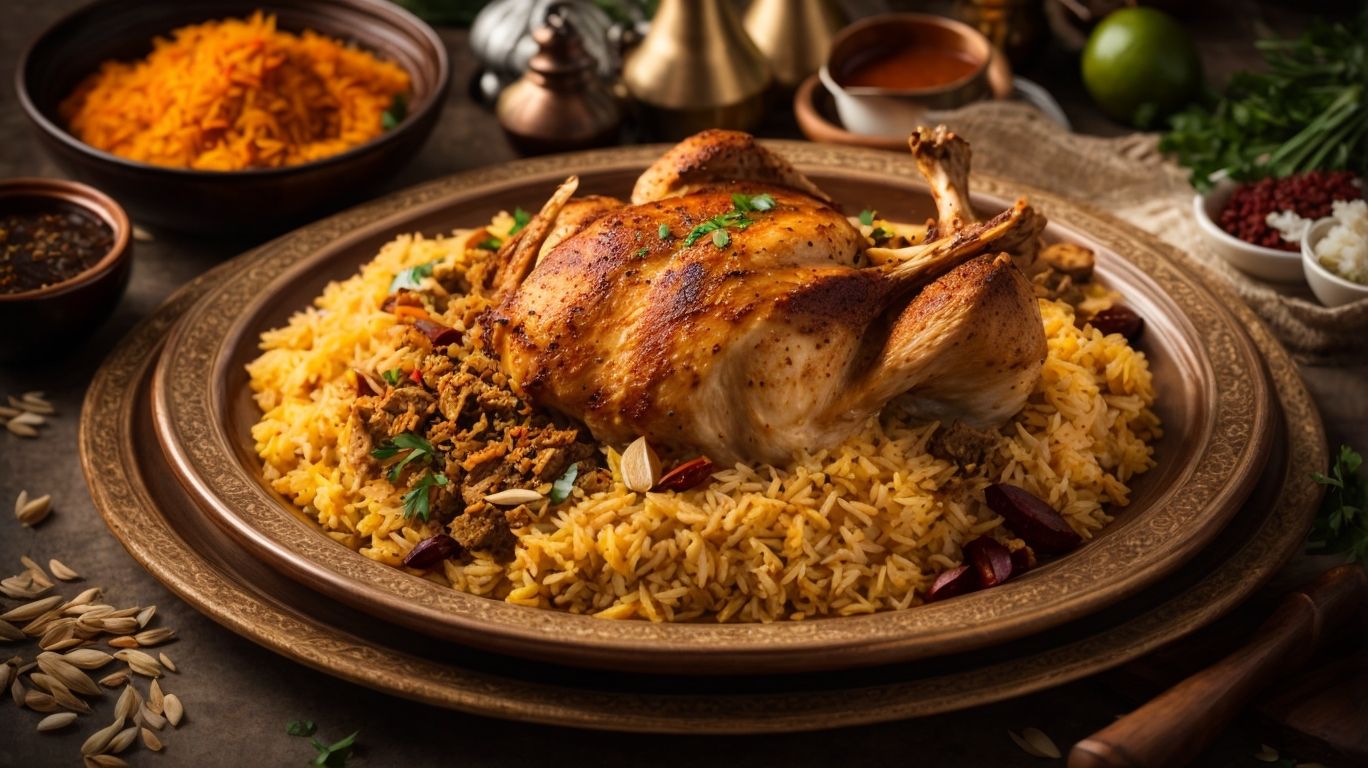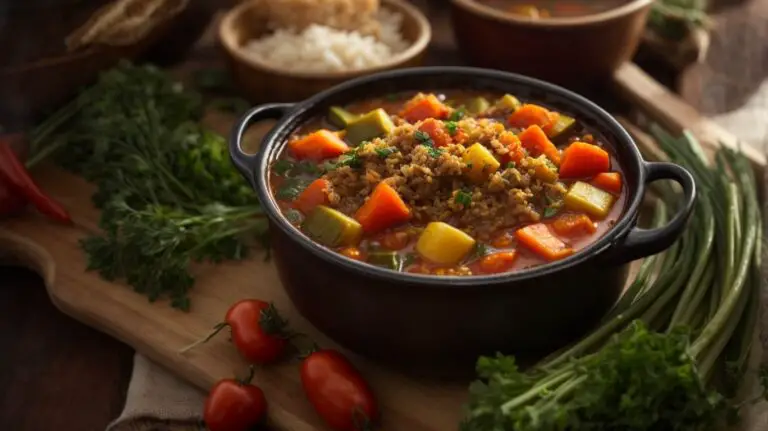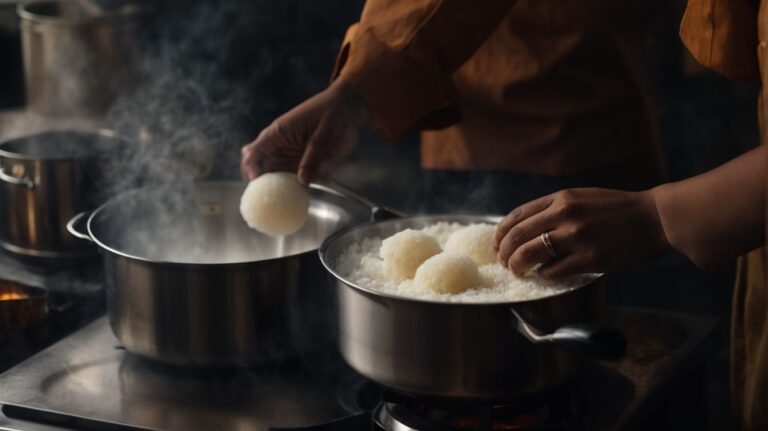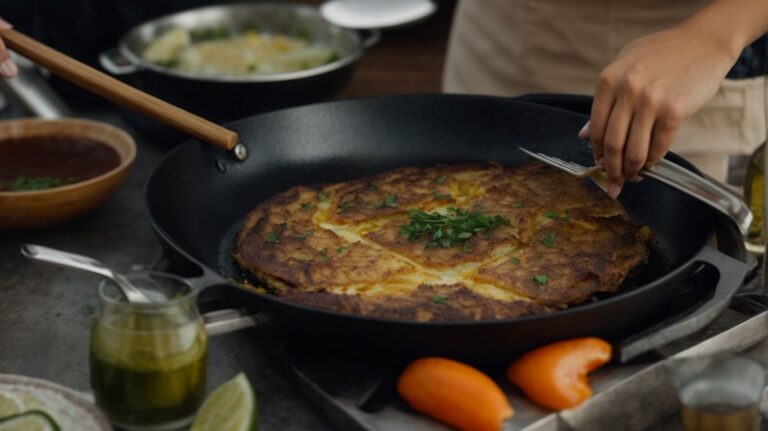How to Cook Kabsa With Chicken?
Are you looking to add a new and exotic dish to your culinary repertoire? Look no further than Kabsa, a traditional Middle Eastern dish that is sure to impress your taste buds.
In this article, we will explore the origin of Kabsa, the essential and optional ingredients needed to make it with chicken, as well as the best practices for preparing and cooking this flavorful dish.
Let’s dive in and learn how to cook the perfect Kabsa with chicken!
Key Takeaways:
What is Kabsa?
Kabsa, a popular Arabian dish, is a flavorful Middle Eastern recipe that takes taste buds on a culinary adventure.
This fragrant dish is believed to have originated in Saudi Arabia, with influences from Indian and Persian culinary traditions. A tantalizing blend of aromatic spices like cardamom, saffron, and cinnamon infuse the rice and meat with a rich, exotic flavor profile. The vibrant colors of the dish, garnished with nuts, raisins, and fresh herbs, not only make it visually appealing but also contribute to the complex taste sensation.
Regional variations in Kabsa can be found across the Middle East and even into North Africa, each adding its own unique twist to the dish. While some versions feature chicken as the primary protein, others may opt for lamb, goat, or even seafood. The cooking methods can vary from slow-cooking in a pot to grilling over open flames, enhancing the dish’s depth of flavor.
Origin of Kabsa
Originating from Saudi Arabia, Kabsa is a traditional dish rich in spices and flavors that exemplify the essence of Arabian cuisine.
The history of Kabsa traces back to the nomadic Bedouins of Arabia who skillfully combined rice with indigenous spices and slow-cooked meats to create a nourishing and flavorful dish. With influences from Persian, Indian, and Mediterranean culinary traditions, Kabsa boasts a unique blend of flavors and aromas that have become synonymous with Arabian hospitality and culture.
Ingredients Needed for Kabsa with Chicken
To prepare a delightful Chicken Kabsa, gather essential ingredients like aromatic basmati rice, fragrant spices, succulent chicken, and flavorful additions like saffron and dried lime.
What are the Essential Ingredients?
The essential ingredients for Chicken Kabsa include fragrant basmati rice, succulent chicken pieces, aromatic spices like kabsa spice, and flavor-enhancers such as garlic and onions.
Basmati rice, known for its long grains and unique aroma, forms the foundation of the dish, providing a fluffy and fragrant base that complements the robust flavors of the chicken and spices. The succulent chicken pieces, whether tender thigh meat or flavorful drumsticks, add a meaty richness to the Kabsa, absorbing the aromatic essence of the spices it’s cooked with.
Traditional Arabian spices like kabsa spice, a blend of cardamom, cinnamon, and bay leaves, infuse the dish with warm, earthy notes that are characteristic of Middle Eastern cuisine. These spices not only season the chicken and rice but also create a symphony of flavors that dance on the palate.
The flavor-enhancers, garlic and onions, provide depth and complexity to the dish. The pungent sweetness of caramelized onions and the sharp, earthy taste of minced garlic elevate the overall taste profile, harmonizing the diverse elements into a cohesive and delectable dish.
What are the Optional Ingredients?
For those seeking to elevate their Chicken Kabsa experience, optional ingredients like unique spices, special occasion enhancements, and one-pot rice variations can add a touch of Middle Eastern flair to the dish.
Consider incorporating aromatic additions such as cardamom pods, saffron threads, or fragrant rose water to infuse the dish with rich flavors and enticing scents.
For a festive twist, garnish the Kabsa with toasted nuts like almonds or pistachios for a delightful crunch.
Experiment with regional influences by including preserved lemons or dried limes to amplify the tangy notes in the dish.
To simplify the cooking process, try utilizing a traditional Middle Eastern pressure cooker for quicker and more efficient preparation without compromising on taste.
Preparing the Chicken for Kabsa
Preparing the chicken for Kabsa involves a meticulous cooking process that begins with selecting a high-quality whole chicken, marinating it with traditional flavors, and grilling it to perfection.
What Type of Chicken to Use?
Selecting the right type of chicken is crucial for a successful Kabsa dish, opt for a whole chicken to capture the authentic flavors and textures in the recipe.
When preparing Kabsa, choosing a whole chicken ensures that the dish absorbs all the rich flavors and aromas from the meat, bones, and skin, resulting in a more robust and satisfying taste profile. Whole chicken allows for a slow simmering process, allowing the meat to tenderize while infusing the broth with depth and complexity. Using a whole chicken maintains the juiciness of the meat and imparts a more intense poultry flavor throughout the dish.
How to Marinate the Chicken?
Marinating the chicken for Kabsa involves infusing it with a blend of aromatic spices, garlic, and traditional flavors inspired by Saudi Arabian culinary heritage.
These spices encompass a rich tapestry of flavors like cumin, coriander, cardamom, and cinnamon, reflecting the intricate taste profile of Saudi Arabian cuisine.
Garlic plays a pivotal role in adding depth and pungency to the marination mix, further intensifying the overall taste.
The use of regional flavors such as saffron and dried limes brings a distinctive touch, elevating the chicken’s succulence and infusing it with a unique character.
Cooking the Kabsa
Cooking the Kabsa dish involves a meticulous process of layering aromatic rice with flavorful chicken and Middle Eastern spices, creating a culinary masterpiece fit for special occasions or everyday dining.
What Type of Pot to Use?
Selecting the appropriate pot for cooking Kabsa is essential to ensure even heat distribution and optimal flavor infusion, choose a pot that suits the occasion and enhances the Middle Eastern dining experience.
For traditional gatherings or family meals, a classic cast iron pot can bring out the rich flavors of the Kabsa spices and meats through slow, steady cooking. The heavy-duty material retains heat well, ensuring that every bite is filled with aromatic goodness.
On the other hand, if you prefer a more modern twist to your Kabsa cooking, a stainless steel pot provides efficient heat conduction and is easy to clean, ideal for quick weeknight dinners.
Whether you opt for a traditional or contemporary style pot, remember that the vessel plays a significant role in perfecting your Kabsa dish.
What is the Cooking Process?
The cooking process of Kabsa involves simmering fragrant rice with tender chicken pieces, aromatic spices, and Middle Eastern flavors until a delightful dish is ready to be served, reminiscent of Dubai’s culinary delights.
Traditionally prepared in Saudi Arabia, Kabsa showcases a blend of flavors that exemplifies the rich culinary heritage of the region. To start the cooking process, a mix of coriander, cardamom, and other traditional spices is sautéed to release their essence, infusing the oil with tantalizing aromas. Next, the chicken is browned to lock in its juices before being simmered in a broth composed of tomatoes, onions, and the signature spice blend.
Serving and Presentation
Serving and presenting Kabsa is an art that involves arranging the aromatic dish with precision, adding garnishes that elevate the dining experience, suitable for special occasions or a taste of Middle Eastern charm.
How to Plate the Kabsa?
Plating Kabsa involves artful presentation techniques that showcase the colorful layers of aromatic rice, succulent chicken, and fragrant spices, enhancing the dining experience with a touch of Middle Eastern sophistication.
When plating Kabsa for a special occasion, consider elevating the presentation by incorporating Dubai’s culinary aesthetics. Sprinkle a festive blend of saffron threads and slivered almonds on top for a royal finish. Arrange the dish on intricately designed plates or vibrant ceramic platters that resonate with Arabian charm.
What are Some Garnishing Options?
Garnishing Kabsa offers an opportunity to embellish the dish with a variety of spices, herbs, and colorful additions that not only enhance the visual appeal but also elevate the flavor profile, perfect for special occasions and embracing Middle Eastern culinary traditions.
Consider infusing your Kabsa with fragrant spice blends like baharat or Lebanese seven spice to add complexity and depth to the dish. For a burst of freshness, garnish with coriander leaves or mint before serving. Pomegranate seeds or sliced almonds not only provide a delightful crunch but also introduce a pop of color to the plate, making it visually appealing for a festive table setting.
Tips and Tricks for the Perfect Kabsa
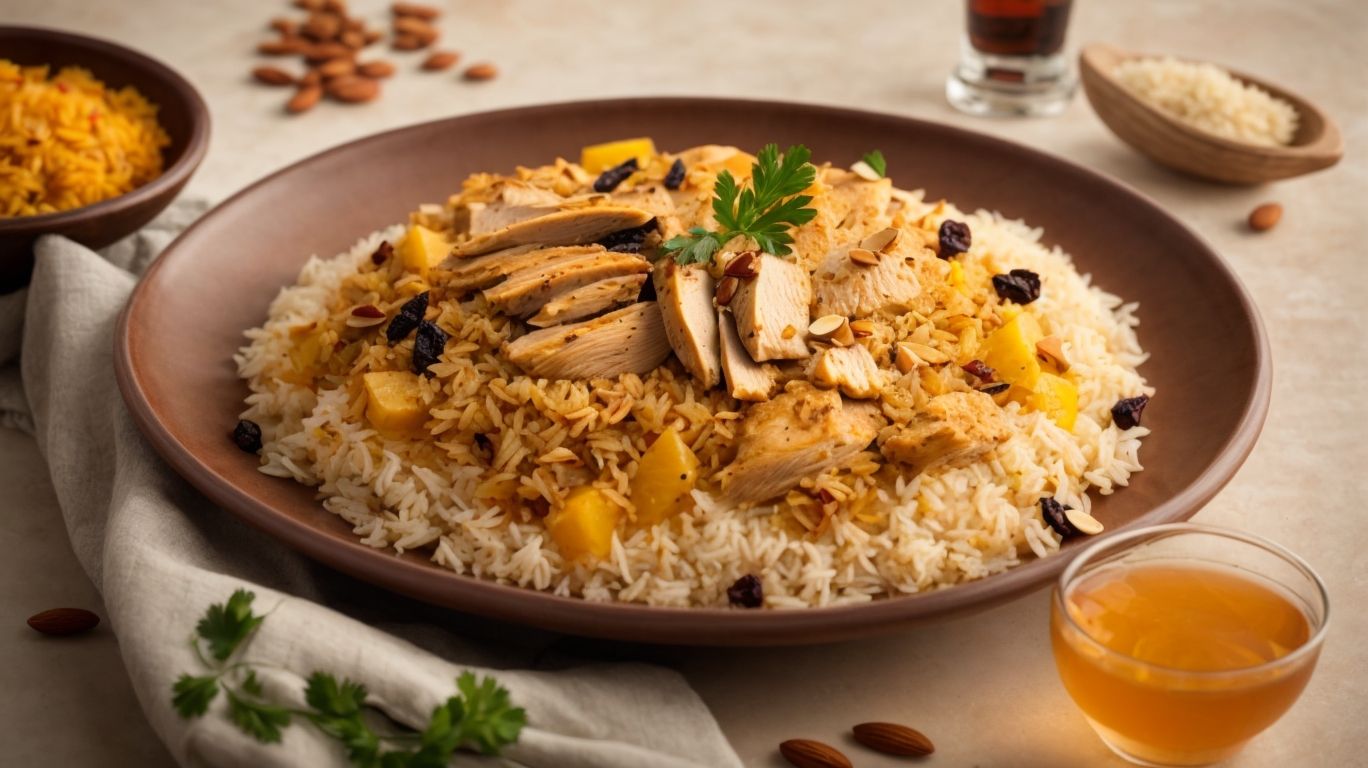
Credits: Poormet.Com – Timothy Garcia
Mastering the art of preparing the perfect Kabsa requires attention to detail, from selecting premium spices to mastering the cooking process, ensuring a delightful culinary journey through Middle Eastern flavors, ideal for special occasions or everyday dining.
How to Adjust the Spice Level?
Adjusting the spice level in Kabsa allows for a personalized culinary experience, with the flexibility to tailor the dish’s flavors to suit individual preferences, offering a taste of Middle Eastern flair reminiscent of Dubai’s gastronomic delights.
One way to adjust the spice level in Kabsa is by varying the amounts of cardamom, cinnamon, and black pepper used in the spice blend.
Experimenting with different combinations of cumin, coriander, and nutmeg can create unique flavor profiles that cater to diverse taste preferences.
Customizing the heat level with chili powder or paprika adds a kick to the dish while maintaining its authentic essence.
What are Some Common Mistakes to Avoid?
Avoiding common mistakes in Kabsa preparation ensures a seamless culinary journey through Middle Eastern flavors, steering clear of pitfalls that may hinder the dish’s authenticity or gastronomic experience, perfect for those seeking a taste of Dubai’s culinary magic.
One of the crucial aspects to pay attention to is the rice consistency; Kabsa’s success heavily relies on achieving the ideal balance between fluffiness and stickiness that defines this dish.
Overcooking the rice can result in a mushy texture, while undercooking may leave it hard and unpleasant to eat. To get it just right, start by rinsing the rice thoroughly to remove excess starch and then adjust the cooking time accordingly.
Another misstep is neglecting the spices. Kabsa’s rich flavor profile comes from a harmonious blend of spices like cumin, coriander, cardamom, and cinnamon. Failing to incorporate these in the right proportions can lead to a bland or overpowering taste.
Conclusion
Kabsa encapsulates the vibrant flavors and culinary essence of the Middle Eastern region, offering a delightful culinary adventure that transports diners to the heart of Dubai’s gastronomic delights.
Kabsa, often hailed as the national dish of Saudi Arabia, is an iconic symbol of shared culinary heritage across the Middle East regions. The dish, rooted in Bedouin culture, combines fragrant spices, succulent meats, and aromatic rice in a harmonious blend that reflects the diverse cultural tapestry of the Arabian Peninsula. Kabsa’s popularity in Dubai not only highlights the city’s culinary diversity but also serves as a bridge connecting locals and visitors alike to the rich flavors and traditions of authentic Middle Eastern cuisine.
Final Thoughts on Cooking Kabsa with Chicken
As the journey of cooking Kabsa with Chicken culminates, it leaves behind a lingering aroma of exotic spices and rich flavors that epitomize the Middle Eastern dining experience, perfect for special occasions or a taste of Dubai’s culinary charm.
The combination of aromatic ingredients like cinnamon, cardamom, and saffron creates a symphony of tastes that dance on the palate with each bite, bringing warmth and depth to every mouthful. The cultural significance of Kabsa as a dish that unites people over a shared meal is truly remarkable, reflecting the hospitality and generosity ingrained in Middle Eastern traditions.
Whether you are celebrating a special event or simply craving a culinary adventure, Kabsa with Chicken offers a delightful journey through flavors that will transport you to the vibrant streets of Dubai, where every bite tells a story of heritage and flavor.
Frequently Asked Questions
What is Kabsa and how do I cook it with chicken?
Kabsa is a traditional Middle Eastern rice dish that is typically made with chicken. To cook it, you will need to follow a few simple steps that involve preparing the chicken, cooking the rice, and then combining them together.
What type of chicken should I use for Kabsa?
Traditionally, Kabsa is made with a whole chicken cut into pieces. However, you can also use bone-in chicken thighs or chicken breast if you prefer. Just make sure to adjust the cooking time accordingly.
Can I use frozen chicken for Kabsa?
Yes, you can use frozen chicken for Kabsa, but it is recommended to thaw it completely before cooking. This will ensure that the chicken cooks evenly and thoroughly.
How do I season the chicken for Kabsa?
The chicken for Kabsa is typically seasoned with a blend of spices such as turmeric, cumin, coriander, and black pepper. You can also add garlic, ginger, and onion for extra flavor.
Do I need to marinate the chicken for Kabsa?
Marinating the chicken is not necessary for Kabsa, but it can enhance the flavor. If you have time, you can marinate the chicken in the spice blend for 30 minutes to an hour before cooking.
Can I make Kabsa without chicken?
Yes, you can make Kabsa without chicken. You can substitute the chicken with beef, lamb, or even fish. Just make sure to adjust the cooking time and seasonings accordingly to accommodate the different protein.

